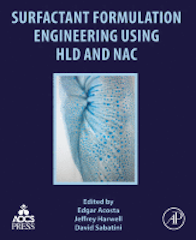Cc Values
Quick Start
To use HLD we need the characteristic value of our surfactant, its Cc. We might be able to find it in the new, updated list below. We might be able to measure it. But if it's a mixture, or if we want to tune the Cc rationally, then we need to calculate the value of the mixture. Easy! It's the molar-based average of the individual surfactants, so we need the weight % and the MWts of the two surfactants.
Cc Values
Each surfactant is characterised by a Cc value. A very hydrophilic surfactant such as SLS has Cc = -2.3 and a hydrophobic surfactant such as AOT has Cc = 2.6. But what is Cc? The name was originally Characteristic Curvature. There are good thermodynamic reasons why the name is appropriate. But for practical purposes let's just call it Cc (perhaps imagine it meaning Characteristic) because that's what is generally used in the literature.
 More important than the name are the values. Heroic research over a number of years has produced a set of values for some common surfactants. Not all the values are perfectly accurate (partly because "the same" surfactant from one supplier can often be different from "the same" surfactant from another supplier), but they are generally a good starting point. Lower down is the historical list of values I assembled with "best endeavours".
More important than the name are the values. Heroic research over a number of years has produced a set of values for some common surfactants. Not all the values are perfectly accurate (partly because "the same" surfactant from one supplier can often be different from "the same" surfactant from another supplier), but they are generally a good starting point. Lower down is the historical list of values I assembled with "best endeavours".
But in 2025 after extensive mining of the literature, Acosta and colleagues produced a table of Cc values with many other values in their book: Surfactant Formulation Engineering using HLD and NAC edited by Acosta, Harwell and Sabatini.
Chapter 1 containing Table 1.1 is available as the preview in the link above, and the table below lists the key experimental values for HSP available from that preview (other important values are included in Table 1.1 but they are not not included here). The salinity column b shows I for the ionics which typically have a log(S) dependency.
Use the values in this table rather than the ones in the old table further down this page. In addition to searching for a surfactant, you can click any column header to sort, click again to reverse direction.
| Name | MWt | K | aT/°C | b | Cc |
|---|
Cc of blends
If your surfactant isn't quite what you want (or to put it another way, if you want to tune your system by varying the surfactant) a most convenient fact is that the Cc of a mixture of surfactants is the mole weighted average of the Ccs of the surfactants. Because it is the mole-weighted average the MWt of each surfactant needs to be known. You get more "bang for your %Cc" with a small MWt surfactant. The calculator at the top of the page does the hard work for you.
To get used to the calculations it can be a good idea to set % = 50 and Cc1 = -1 and Cc2 = 1. If the MWt values are identical then the Cc of the mix should be 0. If you increase the MWt of #1 then there will be fewer moles of #1 in the mix so the Cc increases towards the value set by #2. Decreasing the MWt of #1 sends the Cc towards that of #1. The effect of the MWts of surfactants are another complication of surfactant space which often causes confusion. With HLD apps the molar mixing rule is always taken into account.
Manufacturers Cc values
It has always seemed obvious to me that manufacturers would want their Cc values to be known. But progress is slow. I had, unfortunately, missed the fact that Sasol had published2 an interesting set of their own values, though the academic paper made it a little hard to translate into user-friendly values. Thanks to the help of Dr Thu Landry (Nguyen), I can now provide this table of their values. Their alkyl chains such as FT-Oxo are described in their paper and on their website but are basically diffent types of branching:
1Davide Schirone, Giuseppe Tartaro, Luigi Gentile, Gerardo Palazzo, An HLD framework for cationic ammonium surfactants, JCIS Open 4 (2021) 100033
2Thu T. Nguyen, Carla Morgan, Laurie Poindexter, Jorge Fernandez, Application of the Hydrophilic–Lipophilic Deviation Concept to Surfactant Characterization and Surfactant Selection for Enhanced Oil Recovery, J Surfact Deterg, 22, 983-999, 2019


